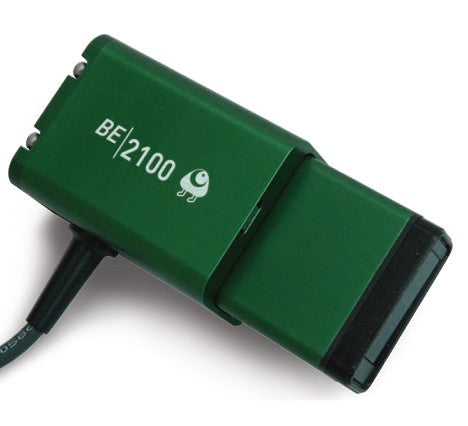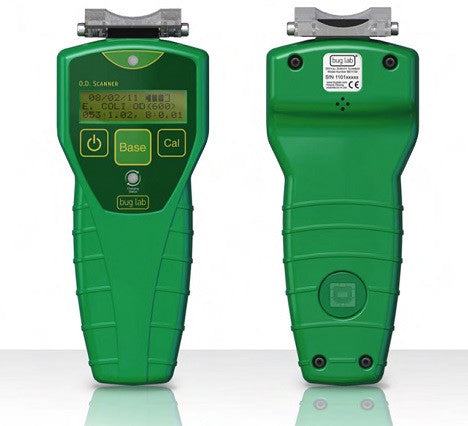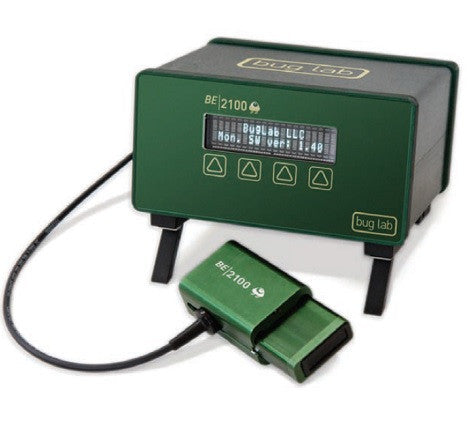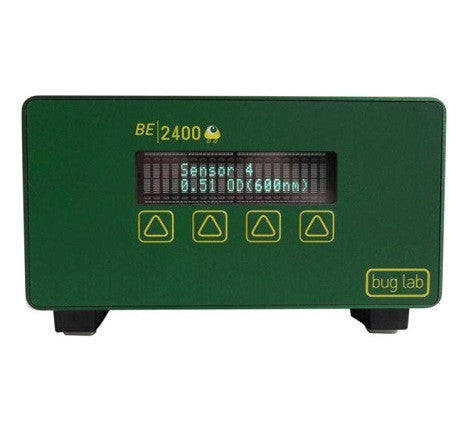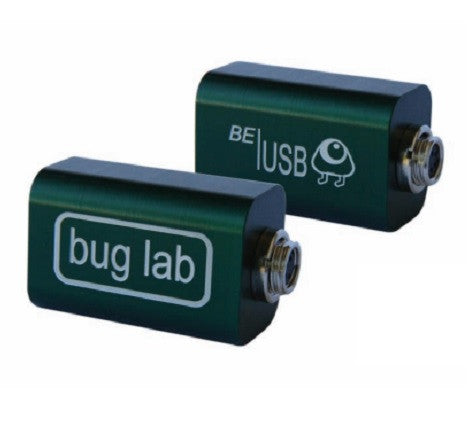BE2100 Sensor - Non-Invasive Biomass Monitoring System
Supplied By: Buglab, USA
Rs. 0.00
BE2100 Sensor: Industry Leading, Non-Invasive Biomass Monitoring System
The BE2100 is an industry-leading, non-invasive biomass monitoring system designed for use in both research laboratory and industrial environments. It provides continuous, real time, and online biomass measurements of your fermentation culture. The sensor is easily secured to the outside of a variety of different fermentor types, from small glass vessels to large stainless steel vessels with glass viewing ports. Since no immersion port is required, the need for sensor sterilization is also eliminated.


Real-time, Online Monitoring
The BE2100 Biomass Monitoring System consists of a sensor that attaches to a fermentor or bioreactor, and one of three options to control the sensor: a BE2100 base unit (single sensor), a multiplexing BE2100 Base Unit (up to 4 sensors), or the BE|USB (direct USB adapter for single sensor), all of which interface with the included software, providing the user intuitive controls and the ability to track the progress of fermentation in real time. The software can calibrate the sensor output to any desired units (OD, g/L, cells/mL, etc.) as well as track important events during the fermentation. The BE2100 and BE2400 base units comes equipped with serial RS-232, USB and 4-20 mA analog outputs and can function as a stand-alone device or can be controlled through software via RS-232 or USB, enabling straightforward integration into a fermentor control system.
Ultra-Wide Linear Range
Most immersion probe methods are limited in the range of biomass growth they measure. The BE2100 sensor on the other hand employs a novel method of optical monitoring that responds linearly to biomass over a very wide range of growth: from less than 0.1 to greater than 300 OD units.
How it Works
Traditional optical biomass probes rely on a single emitter-detector, resulting in a sensitivity to biomass that is highly non-linear and limited in range. The BE2100 sensor employs an array of infra-red lasers and detectors. Each of the laser-detector pairs in the array is sensitive to a different range of biomass changes. The BE2100 advantage is conferred by combining the signals from each of these pairs in a manner that linearizes its response to biomass changes over a very wide dynamic range.

Options for Connecting one or more BE2100 Sensors
The BE2100 base unit and BE|USB can each accommodate one BE2100 sensor, whereas the BE2400 can accommodate up to four sensors. The diagram below outlines the connectivity options for BE2100 sensors.

Advantages
-
Widest linear range – from <0.1 to >300 OD units – of any biomass monitor
-
Automated, continuous, real-time, online OD measurements
-
Measures through fermentor wall or viewing port – attaches to outside of vessel
-
Works well for both fermentation and cell culture
-
No immersion port required – avoids fouling and contamination
-
Lowest total cost of ownership of any biomass monitor currently available
BE2100 Sensor Specifications
| BE2100 Performance Specifications | |
|---|---|
| Range of OD Sensitivity | 0 to >300 OD units |
| OD Accuracy (Typical RMSE in user-calibrated mode)
|
15% (OD 0.5-300) 0.1OD(0D<0.5) |
| Overall Height
(without feet)
|
82 mm |
| Averaging Time Constant | 3 - 480 sec |
| Performance Verification/Recalibration | Calibration Cups (2) |
| Calibration to External Reference Standards | via user interface software |
| BE2100 Electrical Specifications | |
| DC Power In | 5 V, 90 mA |
| Certifications | CE marked
Tested for compliance to EMC standards EN55011 and EN61000, and safety standard EN 61010
|
| Sensor Communication with base unit or BE2100 | Serial digital (protocol available upon request) |
| Sensor Cable Connector | BE2100 sensor, male (4-wire, threaded) |
| Standard Length | 2000 mm |
| Extension cable
(avail. as accessory)
|
4000 mm |
| BE2100 Physical Specifications | |
| Front Face Width | 15 mm |
| Front Face Height | 41 mm |
| Overall Length (excluding latch) | 100 mm |
| Active Optical Window (length x width) | 25 x 6 mm |
| Min. Vessel Diameter (std. Strap) | 53 mm |
| Max. Vessel Diameter (extended Strap) | Unlimited |
| Max. Window Depth | 31 mm |
| Functions with Flat Surfaces | Yes |
| Body | Aluminium |
| Gasket | PVC |
| Filter | Acrylic |
| Strap | Nylon |
| Latch | Stainless Steel |
| Fasteners | Stainless Steel |
| Cable, Strain Relief | Polyurethane |
| BE2100 Sensor Environmental and Safety Specifications | |
| Operating Temperature | 0 to 50°C |
| Environmental Seals | Yes - Splash Proof |
| Laser Product Classification | 1M |
BE2100 Sensor Dimensions

BE2100 Sensor Software
BugLab includes our data logging software, with our sensors, at no additional charge.
The data logging software allows the user intuitive controls and the ability to track the progress of fermentation in real time.
The user experiences real time, online data collection while the sensor is connected to the PC. Profiles such as the type of measurement can be easily customized and uploaded to your sensor through the software, such as g/L, cells/ml, OD, etc.
Events can be logged at any time, such as sampling, glucose input, agitation increase, inoculation and a range of other customizable inputs.
Baseline corrections can be noted as well, at any time during the run, to account for media and substrates.
New calibration curves can also, be added through the software when correlating the sensor to your off-line spectrophotometer. This is helpful when working with cell types that are highly differentialized in reflectivity, typically from one cell type to another.
The software allows the end user to export the data to an excel file format for additional graphing.
Data log up to 6 sensors at one time via our USB/BE converter or up to 4 sensors at one time with our BE2100 Base unit. If more than 6 sensors are being used, you may install more than one instance of the software onto your PC for additional logging of the sensor.


Frequently Asked Questions
Q: Does glass thickness matter or what is in front of the sensor?
We have tested glass thicknesses up to 12 mm in wall thickness. The minimum distance to measure from the sensor is 3 cm's. This can result in erroneous readings if you have a baffle or other sensor in the way. Be sure to mount the sensor in a clear place on the vessel.
Q: How does this compare to my spectrophotometer?
Our sensors are calibrated with Saccharomyces cerevisiae in a 14L glass fermentor to Optical Density (OD) measured at 600 nm in a 1 cm cuvette in a spectrophotometer (Perkin-Elmer, model Lambda 9). Due to the differences between the OD measured between different commercially available spectrophotometers, and when an absolute reading of biomass is needed for ensuring protocols, it is recommended to calibrate the BE2100 sensor to the particular organism you are growing using your preferred reference biomass method (e.g. dry cell weight, OD, etc).
Your BE2x00 software can help you to collect and then apply a custom calibration file to the sensor that will correlate to your offline spectrophotometer. Once you apply your calibration file you will no longer need to perform aliquot extraction (or any other classical method) in order to determine biomass or related quantities, as the BE2100 sensor will now do that for you.
Please note that in many applications, where only measurements of the growth rate, or growth trend are needed, it is unnecessary to calibrate the BE2100 sensor, and the pre-installed measurements will suffice.
Q: I work with small vessels less than 250 mls in nature, will this work?
Due to the nature of the optics and technology, the BE2100 sensor needs 3 inches of clearance in your vessel. These small vessels normally do not provide ample amount of room and therefore, one will see fluctuations in the readings as it measures the light reflected not only from the cellular material, but also, from the port penetrations, such as pH and DO sensors, and likely, the agitation shaft. We recommend using the BE2100 sensor with vessels 500mls and above.
Q: Will I see sensitivity to bubbling or high agitation rates like I do in other sensors?
There is some sensitivity with very high bubbling; this is typically only at very low ODs up to about 3 OD units, then bubbles become negligible.
Q: How is this sensor better than the immersible sensors?
The BE2100 uses an array of three source-detector pairs to measure in the low, mid and high OD ranges from .1 < and > 300. We are capable of employing all three due to the amount of space available in the non-immersible sensor. Our users enjoy linearity over a wide range of OD. Immersible sensors can only support the space for one source-detector pair and, therefore, are limited to only one order of magnitude in OD. When charting out cell growth, you will typically see linearity over a short range, and then experience roll off.
Q: What vessel manufacture works best with BugLab's sensor?
The BE2100 works with most manufactured vessels or jars, glass, plastic or stainless steel with sight glass. These include major manufacturers such as Applikon, Eppendorf (New Brunswick Scientific), Sartorius and other vessel providers.
Q: Can I export the data into an excel file?
Using our data logging software, the data that is displayed on the trend graphs can be immediately be exported to a new Excel file by easily right-clicking the mouse over the graph, and selecting Export >> Export Data to Excel.
Q: I would like to have cascade control based on my OD readings, how can I achieve that with my fermentor controller?
You will need the optional BE2100 Base Unit to do this. Both the BE2100 and BE2400 multiplexer have an analog ouput that is proportional to biomass (BE2100 and BE2400) or growth rate (BE2100 only). The nominal range of the current is 4 to 20 mA. Several fermentor controllers analog to digital converters to accept this signal. A resistor is provided in order to convert the signal from Amps to Volts, if needed. Alternatively, check in with your fermentor manufacturer, as some have written drivers to accept the serial communication directly from the BE2100 sensor.
Q: Can you use the sensors in mammalian applications?
Mammalian cells tend to grow in a very low, detectable range .01 to 2 during its entire culture. In this lower range is where we see sensitivity to bubbling. Our current offering is best suited for microbial, fungal and plant applications.
Related Products

